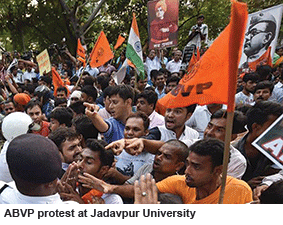 Corruption, scandals, rise of party-cadre syndicates under its watch and the alliance of the Communist Party of India-Marxist with the Congress notwithstanding, the Trinamool Congress (TMC) scripted history in West Bengal, routing the opposition and bagging 211 of the 294 seats in the West Bengal assembly elections which concluded on May 5.
Corruption, scandals, rise of party-cadre syndicates under its watch and the alliance of the Communist Party of India-Marxist with the Congress notwithstanding, the Trinamool Congress (TMC) scripted history in West Bengal, routing the opposition and bagging 211 of the 294 seats in the West Bengal assembly elections which concluded on May 5.
Although all opposition parties including the CPM, which ruled West Bengal for 34 years (1977-2011) until it was routed by TMC five years ago received a drubbing, the greatest loss was suffered by the Bharatiya Janata Party (BJP) which rules the country from New Delhi. The vote share of the BJP which had expected to do well, plunged 7 percent lower than in General Election 2014. This, despite the fact that for the past two years after it swept to power at the Centre with an absolute majority in the Lok Sabha, the BJP and particularly its student wing, the Akhil Bharatiya Vidyarthi Parishad (ABVP) have been making strenuous efforts to displace CPM-affiliated student unions and penetrate education institutions in West Bengal.
Since 2011, West Bengal’s 372 colleges and 32 universities have become battlegrounds with the student wings of the CPM, the ruling TMC and BJP repeatedly engaged in violent confrontations to influence students and win elections. The latest confrontation occurred on May 6 when ABVP students staged a screening of BJP-sympathiser Vivek Agnihotri’s 108-minute feature film Buddha in a Traffic Jam on the campus of Kolkata’s highly-respected Jadavpur University (JU).
Buddha in a Traffic Jam narrates how Left-wing pro-Naxalite intellectuals take advantage of gullible students, show them utopian dreams and transform them into terrorists. As a retort, the CPM-affiliated Forum for Arts Students (FAS) and Democratic Students’ Front (DSF) screened Muzaffarnagar Baaqi Hai, a film depicting the violent and reportedly BJP-inspired communal riots that tore through Shamli and Muzaffarnagar districts of Uttar Pradesh in August-September 2013, leaving an estimated 100 dead and 50,000 displaced, the majority of them Muslims.
In heated exchanges and scuffles that followed the screening of Muzaffarnagar, several women students were allegedly manhandled and molested by ABVP activists. Both sides filed police reports against each other. The next day, JU students held a protest march prompting the ABVP to describe JU as a “hub of anti-nationals”.
Academics in West Bengal are convinced that youth wings of the BJP and TMC are determined to capture the state’s higher education institutions from the CPM, starting with JU. “Leftists are all anti-nationals. We will fight tooth and nail to gain a foothold in the JU campus and weed out the Leftists,” said ABVP’s secretary Subir Haldar on May 7. On the other hand, the Left wing parties and TMC students’ union have joined forces to fight the saffron offensive.
“Though successful in capturing smaller colleges and campuses, the RSS has failed to penetrate the country’s major institutions such as Hyderabad Central University (HCU), Jawaharlal Nehru University (JNU) and now Jadavpur University, where there are strong intellectual traditions. It will be very difficult for the intellectual lightweights of RSS and the sangh parivar to make headway in JU,” says Ambikesh Mahapatra, chemistry professor in JU who fought the recent assembly election as an independent candidate supported by the CPM-led Left Front.
After targeting HCU and JNU, Jadavpur University is clearly in the crosshairs of the BJP and its cohorts. But following the severe drubbing the BJP has received in the recently concluded legislative assembly elections, the chances of Trinamool Chhatra Parishad making inroads into West Bengal’s institutions of higher education are much brighter than of Leftist and saffron unions.
Baishali Mukherjee (Kolkata)